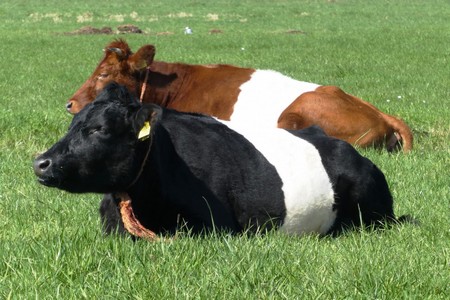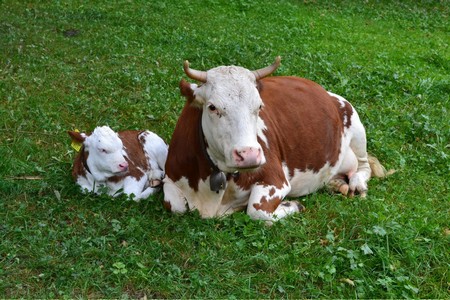Problemen bij afkalven zijn in te schatten voor de inseminatie
Een klein percentage koeien heeft problemen tijdens het afkalven. Veefokkers zouden graag willen weten welke koeien dat risico lopen. Op basis van een grote dataset die veeteeltbedrijf CRV bezit hebben computerwetenschappers aan de RUG met behulp van kunstmatige intelligentie een voorspellend model ontwikkeld dat – in theorie – het aantal complicaties kan halveren. Zij publiceerden hun model op 5 december in het tijdschrift Preventive Veterinary Medicine.
Veeteelt is tegenwoordig een echte data-wetenschap. Veeteeltbedrijven leveren zaad van stieren en registreren het succes van hun nakomelingen in detail. De melkopbrengst van de koeien en vele andere gegevens zijn verzameld en opgeslagen in een enorme database, samen met genetische informatie over de dieren. Op die manier is het mogelijk een ‘geschatte fokwaarde’ toe te kennen aan dieren, en zo een optimale match vinden tussen stier en koe.

Risico
Een belangrijk aspect van veefokkerij is de geboorte van kalfjes. In ongeveer 3,3 procent van de gevallen ontstaat er een complicatie tijdens het afkalven, iets dat dystocia wordt genoemd. ‘Dat kan van alles zijn, bijvoorbeeld dat het kalf uit de moeder getrokken moet worden, of een ingreep van de veearts’, vertelt Ahmad Alsahaf. ‘Er zijn modellen om het risico op dystocia te voorspellen, maar die werken met gegevens die pas beschikbaar zijn na inseminatie van de koe. Wij wilden een model ontwikkelen dat voor inseminatie het risico kan bepalen.’
Alsahaf is nu postdoc bij de afdeling Biomedische Wetenschappen van Cellen en Systeem in het Groningse UMCG, maar werkte aan dit voorspellende model voor dystocia tijdens zijn promotieonderzoek bij de onderzoeksgroep Intelligente Systemen van het Bernoulli Instituut voor Wiskunde, Computerwetenschappen en Kunstmatige Intelligentie aan de RUG.
‘De vraag naar zo’n model kwam van veefokbedrijf CRV. Zij gaven ons daarvoor een grote dataset met informatie over koeien en stieren’, zegt Alsahaf. ‘We gebruikten eerst een systeem voor machinaal leren om de data te analyseren en een voorlopig model te maken. Daarna controleerden we of de belangrijkste risicofactoren die hieruit kwamen ook echt relevant waren. Dat bleek zo te zijn, dus gingen we verder met het bouwen van een volledig model.

Onbalans
Dit proces kende twee grote uitdagingen. Het eerste was de noodzaak de beschikbare data op te schonen en geschikt te maken voor gebruik. Het tweede probleem was dat slechts 3,3 procent van alle koeien complicaties krijgt tijdens afkalven. ‘Daardoor was er een grote onbalans in de dataset’, legt Alsahaf uit. Om dit op te lossen maakte hij een groot aantal kleinere deelbestanden uit de data, waarin wel ongeveer evenveel koeien met en zonder dystocia zaten. Die deelbestanden voegde hij weer samen om het voorspellende model te trainen. ‘Vervolgens testten we het model op een deel van de data die niet was gebruikt in de training.’ De voorspellingen van het model bleken significant beter te zijn dan is te verwachten op basis van toeval.
Alsahaf: ‘Een collega berekende vervolgens dat, onder ideale omstandigheden, ons model ongeveer de helft van het aantal gevallen van dystocia kan voorkomen. Maar dan moet je wel voor iedere inseminatie de ideale combinatie van koe en stier kunnen kiezen, wat in de praktijk niet altijd mogelijk is.’ Maar het model kan boeren en veefokkers zeker helpen bij het inschatten van de risico’s voor inseminatie. ‘Dat is belangrijk, want bestaande modellen hebben informatie nodig die pas na inseminatie beschikbaar is, wat betekent dat je de complicaties niet kunt voorkomen.’
Referentie: Ahmad Alsahaf, Radu Gheorghe, André M. Hidalgo, Nicolai Petkov and George Azzopardi: Pre-insemination prediction of dystocia in dairy cattle. Preventive Veterinary Medicine, 5 December 2022
Meer nieuws
-
05 november 2025
Tien jaar tegels wippen
-
04 november 2025
Protheses waarbij de mens centraal staat
-
04 november 2025
AI-Fabriek in Groningen zorgt voor digitale soevereiniteit
